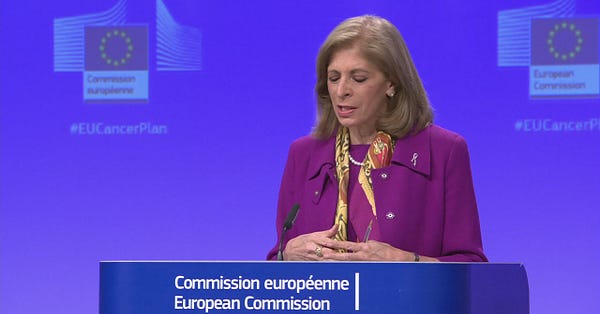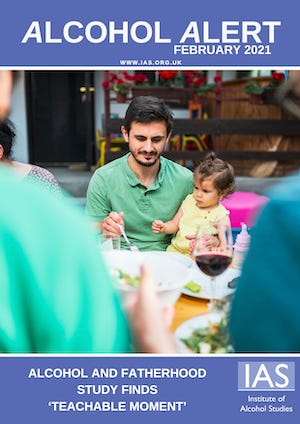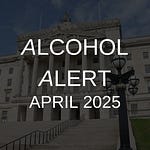Hello and welcome to the Alcohol Alert, brought to you by The Institute of Alcohol Studies.
In this edition:
Pubs pray for Easter resurrection – government roadmap out of lockdown urges hospitality to wait a little longer for salvation
Several studies uncover more evidence of the impact of home drinking during the COVID-19 pandemic
The European Union promises to beat cancer by tackling alcohol labelling
Dr Elena Dimova presents a review exploring men’s drinking habits in the context of becoming a father 🎵 Podcast feature 🎵
Alcohol policy experts and public policy think tank urge the chancellor to raise duty for the good of the nation‘s health ahead of Budget 2021
Child calls about parental alcohol misuse soar during pandemic, say NSPCC
Road safety group urge the government to follow other nations’ drink-driving policies
We hope you enjoy our roundup of stories below: please feel free to share. Thank you.
Lockdown: Easter resurrection for pubs?
This month saw rumours about pubs reopening post-lockdown reach a crescendo among the British press. The Sun and The Telegraph reported that as part of ministers’ determination ‘to open properly this time’, they planned to phase in the sale of alcohol, first by ‘allowing pubs to serve takeaway alcohol in April’, before a full reopening in May (05 Feb).
However, headlines such as ‘Pubs and restaurants could reopen in April – with no alcohol’ drew ire from several sources. According to The Mirror (06 Feb), ‘a senior Government source was dismissive about the idea, telling PA: “We are not going to open pubs that can't sell booze. What would be the point of that?”’
Many industry figures echoed this sentiment, such as Emma Clarkin of the British Beer & Pub Association, who wrote: ‘Opening pubs without selling alcohol is not “reopening” pubs at all’ (Morning Advertiser, 08 Feb). The trade body also claimed that the proposal wouldn’t help almost 30,000 of the country’s pubs – 60% – which would remain shut ‘because their beer gardens are too small for social distancing‘ (Mail Online, 16 Feb).
A study from Stirling University suggests that the government may have had good cause to treat the prospect of reopening pubs with caution (Journal of Studies on Alcohol and Drugs, 16 Feb). Observing a varied range of venues operating under detailed guidance from government intended to reduce COVID-19 transmission risks over the summer of 2020, researchers found that practices were variable and a number of incidents of greater concern were observed, including close physical interaction between customers and with staff, which frequently involved alcohol intoxication and were rarely effectively stopped by staff.
Professor Niamh Fitzgerald, Director of the University of Stirling’s Institute for Social Marketing and Health, who led the research, wrote that ‘despite the efforts of bar operators and guidance from government, potentially significant risks of COVID-19 transmission persisted in at least a substantial minority of observed bars, especially when customers were intoxicated.’


This didn’t stop UKHospitality promising to ‘swiftly, safely and sustainably reopen pubs in April’, issuing their own roadmap to recovery ahead of the prime minister Boris Johnson’s announcement on 22 February (Morning Advertiser, 18 Feb).
In the end, Johnson’s roadmap out of lockdown opted for a four-step approach, in which hospitality venues would open for outdoor service only from no earlier than 12 April (Step 2: including an end to both curfews and serving ‘substantial meal’ requirements), and indoor service would resume alongside it from no earlier than 17 May (Step 3). The prime minister’s plans mean pubs and other licensed venues will have to wait a little longer for salvation.
Research shows impact of pandemic home drinking
Several studies published this month show how the COVID-19 pandemic has both led to soaring levels of home drinking and increases in deaths from alcohol.
One Public Health Scotland (PHS) study (16 Feb), conducted with Glasgow University, showed that despite the fact that the pandemic and related restrictions were associated with a 6% reduction in the total volume of pure alcohol sold per adult in Scotland and in England and Wales, weekly consumption remained above the UK chief medical officers’ guideline of 14 units per week in the first months of the pandemic. Adults drank an average of 17·5 units in Scotland and 16·7 units in England and Wales. However, increases in per adult off-trade sales (28% in Scotland and 29% in England & Wales), did not fully replace the loss of on-trade sales.
A second PHS study (16 Feb), conducted by the University of Sheffield Alcohol Research Group, found that all measures of self-reported weekly off-trade consumption increased during the first three months of the COVID-19 restrictions in both Scotland (+2·4 units per adult) and England (+1·7 units per adult). However, the researchers wrote, ‘these only compensated for some of the losses in on-trade consumption’, as overall self-reported units of alcohol per week fell 0·8 units and 1·5 units respectively. The analysis of population sub-groups also uncovered some worrying signs of drinking behaviours: in Scotland, there was an increase in solitary drinking for single adult households, households with three or more adults, and those in full time education. Overall, PHS concluded that the studies ‘suggest that at a population level people in Scotland were drinking less in the early months of the COVID-19 pandemic than in previous years.’
Another study focusing on the UK as a whole found that more than one in six (17%) UK adults increased their alcohol consumption during lockdown, with a higher proportion of drinkers aged between 18 and 34 years of age (Drug and Alcohol Dependence, 01 Feb). Increased alcohol consumption was independently associated with poor overall mental health, increased depressive symptoms and lower mental wellbeing.
Pandemic takes its toll on alcohol death rates
There are early indications of impact of COVID-19 on alcohol deaths in England and Wales during the first two lockdowns. The Office for National Statistics (ONS) released a provisional dataset showing that there were 5,460 deaths related to alcohol-specific causes registered in the first three quarters of 2020 (Jan to Sept), a 16·4% increase compared with the same nine-month period in 2019. At one point, the death rate reached its highest peak since the data time series began in 2001, of 12·8 deaths per 100,000 people (02 Feb).
Commenting on the findings, Ben Humberstone, deputy director of Health Analysis and Life Events at the ONS said: ‘Today’s data shows that in the first three quarters of 2020, alcohol-specific deaths in England and Wales reached the highest level since the beginning of our data series, with April to September, during and after the first lockdown, seeing higher rates compared to the same period in previous years.
‘The reasons for this are complex and it will take time before the impact the pandemic has had on alcohol-specific deaths is fully understood.’
In the long run, Scotland shows most improvement on alcohol deaths
Long term trends highlight contrasting fortunes between Scotland and the other UK nations in recent years.
The ONS published ‘Alcohol-specific deaths in the UK: registered in 2019’, which found that there were 7,565 deaths (11.8 per 100,000 population) registered in the UK that related to alcohol-specific causes in 2019. This is the second highest number of deaths since the data time series began in 2001.
Between the UK nations, Northern Ireland became the constituent country with the highest alcohol-specific death rate in 2019 (18.8 deaths per 100,000), partly because of its worsening rates (2019 saw the mortality rate reach a record high of 18·8 per 100,000 people) and partly because of Scotland drastically lowering its rate over the same period – Scotland is only UK nation to show statistically significant improvement in its alcohol-specific death rates since records began in 2001.
Alcohol deaths, an ageing problem
Trend data also indicate that the mortality rate crept upwards over the period, exposing the emerging phenomenon of middle-age / older drinkers’ ill health: there were significant increases since 2001 in the rate of alcohol-specific deaths of people aged 55 to 79 years.
The report noted that: ‘Given that the definition of alcohol-specific deaths includes mostly chronic conditions, such as alcoholic liver disease, the increased rates in the older age groups may be a consequence of misuse of alcohol that began years, or even decades, earlier’.
EU promises to beat cancer by tackling alcohol labelling
EU commissioners agreed to propose placing mandatory health warnings on alcoholic beverages by 2023, as part of Europe’s Beating Cancer Plan (POLITICO, 03 Feb).
Brussels will also propose labelling alcoholic beverages with ‘mandatory indications’ of their ingredients and nutritional contents by the end of 2022. The measures will be part of a Commission review of its promotional policy for alcoholic beverages.


An earlier draft of the plan had: proposed including calorie content information on labels; committed the Commission to ‘stop stimulating consumption of alcohol via the EU promotion programme for agricultural products’ and to review EU legislation relating to the taxation of alcohol and on cross border purchases of alcohol by private individuals; and called for the Commission to ‘closely work with member states to reduce online marketing and advertising’ as a way of reducing young people’s exposure to alcohol promotion. However, these proposals were dropped from the final version.
Both industry and public health figures welcomed the plan, albeit for different reasons. Ulrich Adam, the director general of industry group spiritsEUROPE, said they were ‘heartened to see that the Commission plans to encourage self- and co-regulatory initiatives related to marketing, an area in which our sector has long delivered on ambitious standards and targets’.
Mariann Skar, secretary general of European Alcohol Policy Alliance, said in a press statement: ‘It is high time that the forgotten link between alcohol and cancer is brought to the attention of the public. As consumers we have the right to know about the effect’s alcohol consumption has on our health. There needs to be better public information, more awareness among health professionals and effective public health measures to highlight this link and to further promote action to reduce avoidable illnesses and deaths.’
Alcohol and fatherhood study finds ‘teachable moment’
🎵 Podcast feature 🎵
New fathers’ voices are almost absent in relation to their experiences of alcohol use and of research on the effectiveness of interventions to support them to reduce alcohol consumption, according to a new report published under the IAS Small Grants Scheme (25 Feb).
Dr Elena Dimova, research fellow at Glasgow Caledonian University, conducted a scoping review of the literature on the subject of alcohol and fatherhood. Qualitative studies suggested that men may reduce their drinking to support their pregnant partner. However, men’s alcohol consumption beyond this narrow focus is rarely explored. Another study explored in depth men’s views of problematic drinking during fatherhood and found that men believed that fathers should be a role model for their children. The review also identified two interventions, of which one showed significant reduction in alcohol use among fathers, suggesting that couple-based interventions may be effective in addressing health behaviours. However, it was a smoking intervention which did not address alcohol directly.
Men (especially those from lower socio-economic backgrounds) are more likely than women to drink at hazardous/harmful levels and to suffer from alcohol-related harm. This is compounded by a gender inequality in relation to men’s involvement in family planning and antenatal care. However, the transition to fatherhood may present a ‘teachable moment’ when men evaluate their health, modify existing health behaviours and adopt new ones.
The findings have implications for researchers and health practitioners, as insufficient understanding of new fathers’ experiences of alcohol use may result in missed opportunities to address hazardous and harmful drinking among men during an important period of transition into fatherhood.
Dr Dimova presented her review, ‘Exploring men’s alcohol consumption in the context of becoming a father’ at the regular Alcohol Occasionals seminars.
You can hear highlights of the event in the February 2021 Alcohol Alert podcast.
In other research
New findings show that alcohol-related violence affects the poorest in society to the greatest degree, with the most deprived groups experiencing up to 14 times as many incidents of alcohol-related domestic violence every year, compared with the least deprived (PLoS ONE, 18 Feb). Drawing data from the Crime Survey for England and Wales for the years 2013/14 to 2017/18, IAS research and policy officer Lucy Bryant and Dr Carly Lightowlers from the University of Liverpool also found that lower socioeconomic groups experience higher prevalence rates of alcohol-related violence overall, and that the likelihood of experiencing these types of violence is affected by a person’s socioeconomic status even when other risk factors known to be associated with violence are held constant.
The researchers conclude: ‘along with action to address environmental and economic drivers of socioeconomic inequality, provision of publicly funded domestic violence services should be improved, and alcohol pricing and availability interventions should be investigated for their potential to disproportionately benefit lower socioeconomic groups.’
Midwife advice about the low risk alcohol guidelines for pregnant women beyond the initial booking appointment can ‘lead to improved outcomes for women and infants’, according to research published in BMC Pregnancy and Childbirth.
An online survey of UK midwives found that of 842 respondents, nearly three fifths (58%, 484) were aware of the 2016 Alcohol Guidelines, from which 91% (438) cited abstinence as a recommendation. The study also found that the vast majority of midwives would always (90%) or usually (7%) advise women to abstain from alcohol during pregnancy at the booking appointment. Just over a third (38%) did so at subsequent antenatal appointments.
Regarding midwives’ opinions about the usefulness of the low risk guidelines, the research team found that the biggest barriers to advising women using those guidelines were: a lack of belief that the guidelines are accurate and represent the best available evidence on alcohol and pregnancy; a belief that the guidelines do not support building a rapport with women; that women do not like being advised about abstinence and a belief that advising women to abstain has no impact on their behaviour.
Midwives were most likely to advise women to abstain from alcohol if the desire and intention was there and if they saw it as integral to their job.
Lesbian, gay and bisexual (LGB) people are significantly more likely to have mental health conditions and report alcohol and drug misuse than heterosexual people, according to a new study led by University College London researchers in collaboration with the University of East Anglia and City University (UCL, 17 Feb).
Published in Psychological Medicine, the research analysed data from the 2007 and 2014 Adult Psychiatric Morbidity Surveys comprising a total of 10,433 people in England aged 16-64, finding no improvement over the period: LGB people remained at higher risk of poorer mental health when compared to heterosexuals.
The prevalence of alcohol misuse was highest in lesbian and gay people, at 37%, compared with bisexual people at 31%, and heterosexuals at 24%.
Given this continued disparity, the report’s authors call for government action to ensure equity in health and social care services.
In Australia, minimum unit pricing (MUP) has seen consumption of high alcohol content such as cheap cask wine slashed in the Northern Territory region. An examination of the policy – which required retailers to charge a floor price of $1.30(AU) per standard drink (10g pure alcohol) from October 2018 – saw a corresponding halving (50·6%) of per capita alcohol consumption in the 12-month period following its implementation compared with the year before (Australian and New Zealand Journal of Public Health, 09 Feb).
Alcohol industry actors use ‘confrontational tactics’ to undermine public health messaging such as the UK’s low risk guidelines, according to research published in the Journal of Studies on Alcohol and Drugs (15 Feb). Interviews with civil servants, parliamentarians, and public health and civil society actors revealed a major public relations campaign in which major alcohol producers strongly criticised the guidance of the UK Chief Medical Officers, rejecting the well-established association between alcohol and cancer ‘without recourse to evidence’. Furthermore, the Portman Group, which was prominent in the industry’s response, failed to instruct their members to carry the revised content on product labels. The authors of the study write that their analysis ‘further calls into question the rationale for co-regulatory and partnership-based approaches with the alcohol industry.’
Budget 2021: Raise duty for the good of the nation‘s health
Public health experts and think tanks are calling on the government to raise alcohol duty to help combat the ill health effects of alcohol ahead of this year’s Budget.
Scottish Health Action on Alcohol Problems (SHAAP) and the Institute of Alcohol Studies (IAS) both wrote letters to Chancellor of the Exchequer Rishi Sunak in support of Alcohol Health Alliance (AHA) UK’s campaign to increase alcohol duty by 2%.
Lindsay Paterson (interim director) and Dr Alastair MacGilchrist (chair) of SHAAP also wrote in favour of a ‘simpler, fairer system which is proportionate, consistent, scaled and regularly uprated’ (15 Feb). Dr Katherine Severi (IAS chief executive) suggested that raising duties would provide the ‘double dividend’ of both reducing the alcohol harms and generating vital public revenues at this crucial time for HM Treasury, when alcohol duty cuts and freezes since 2012 have cost £1·3 billion annually in lost revenue – the equivalent of the salary of 41,000 nurses (10 Feb).
In a blog post for the AHA, Colin Shevills, director of Balance the North East Alcohol Office, noted that a further cut in alcohol duties risks increasing the price differential between the off and on trade, ‘thus making things worse for pubs’ at a time when their trade has been decimated by the pandemic (12 Feb).
Recognising this differential, think tank the Social Market Foundation produced analysis setting out reforms to alcohol duty that could provide a lifeline to the hospitality industry while reducing harmful drinking (19 Feb).
They claim that a ‘pub relief’ on alcohol duty that allowed pubs, bars and other licensed premises to claim back a percentage of the duty costs that they face would ensure that publicans directly benefit instead of brewers, and even if HM Treasury kept alcohol duty revenue-neutral, such a change would boost on-trade beer sales amounts by roughly 95 million additional pints a year.
The next Budget will be held on 03 March 2021.
Child calls about parental alcohol misuse soar during pandemic
The average number of calls to leading children’s charity NSPCC about parental or adult substance misuse rose two thirds (66%) in the first 10 months of the COVID-19 pandemic (NSPCC, 17 Feb).
According to their figures, there was an average of 709 contacts to the NSPCC helpline about parent/adult alcohol/substance misuse a month before the first national lockdown, which increased to 1,178.
This news came during COA Week, led by the charity the National Association for Children of Alcoholics (NACOA), who provide year-round support for children affected by parental alcohol problems. Jonathan Ashworth MP and Josh Connelly from NACOA shared their experiences living with alcohol-dependent fathers in national media outlets including Times Radio.


GEM: UK drink-driving policies in the slow lane
The UK Government could learn from overseas countries’ examples of how to tackle drink-driving, say road safety and breakdown organisation GEM Motoring Assist, as it follows other groups in calling for a review of inadequate drink drive laws as deaths involving drink drivers reached a 10-year high (Fleet World, 17 Feb).
Provisional government statistics for 2019 show that there were an estimated 280 deaths from drink-driving on Great Britain’s roads, 40 more than the previous year and the highest number of deaths since 2009 (Department for Transport, 11 Feb).
This follows a report from the Parliamentary Advisory Council for Transport Safety (PACTS) last month that said UK drink-driving policy needed a major review, advancing solutions such as a lower limit and improved breath testing enforcement.
GEM chief executive Neil Worth said: ‘Levels of police enforcement have decreased by 63% since 2009, whilst the much-heralded roadside evidential breath testing equipment shows no signs of making it into the police toolkit any time soon. As things stand, England and Wales have Europe’s highest drink drive limits, with absurdly long and complex police procedures required to secure a prosecution.’
GEM has instead said that the government should use examples of good practice from other countries – including Estonia, Denmark, Australia, Israel, Belgium, and Finland – as the basis for taking urgent steps to reform the rules around drink-driving.
The UK Alcohol Alert (incorporating Alliance News) is designed and produced by The Institute of Alcohol Studies. Please click the image below to visit our website and find out more about us and what we do, or the ‘Contact us’ button. Thank you.

















